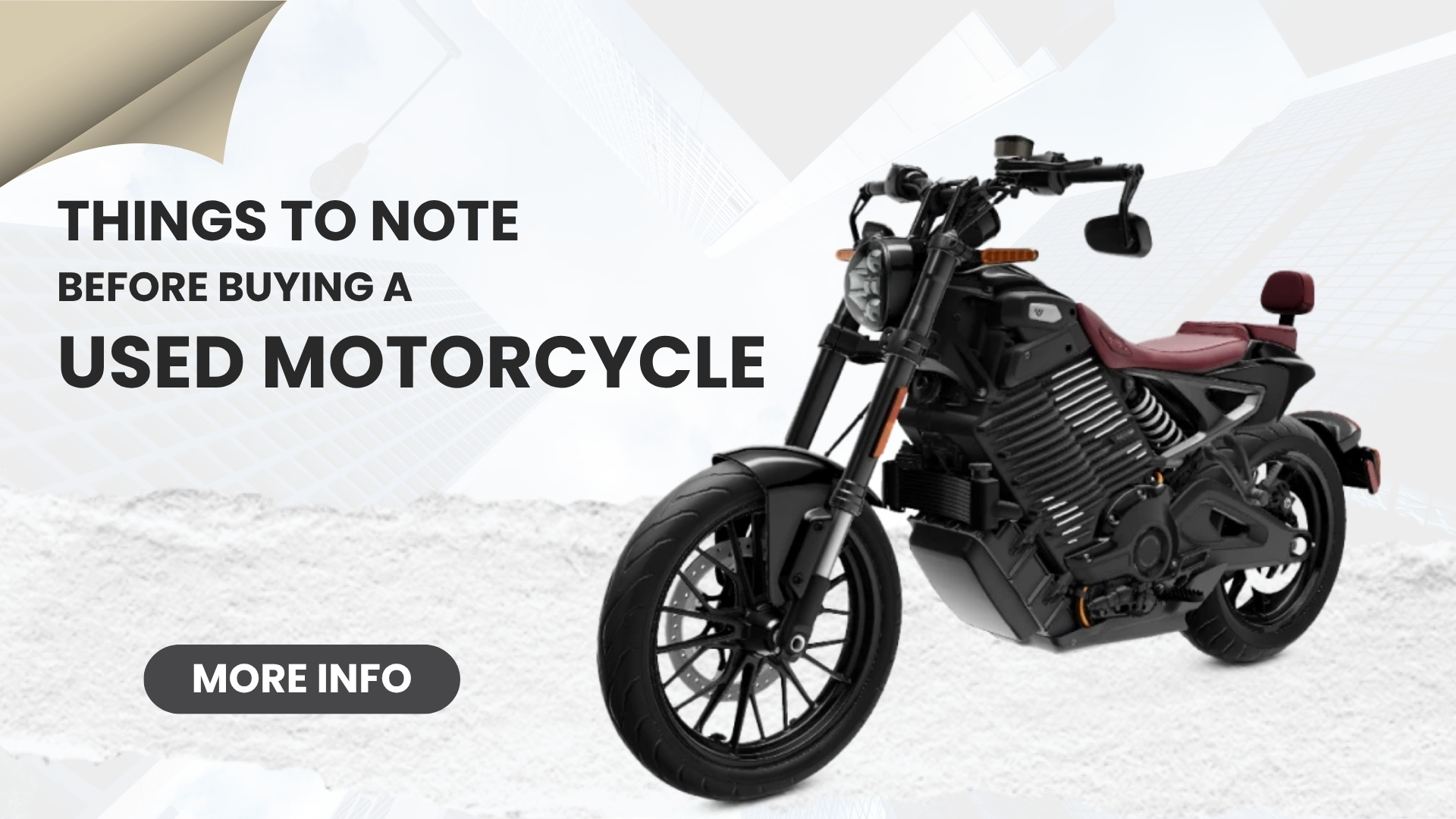Buying a used motorcycle can be an exciting and cost-effective way to hit the open road. Whether you’re a seasoned rider looking for a second bike or a beginner eager to own your first set of wheels, the pre-owned market offers a wide range of options. However, purchasing a used motorcycle isn’t as straightforward as picking the shiniest bike in the lot. There are numerous factors to consider, from mechanical condition and ownership history to paperwork and pricing.
Making an informed decision is crucial to ensure you get the best value for your money and avoid unexpected headaches down the road. In this comprehensive guide, we’ll walk you through the most important things to note before buying a used motorcycle. You’ll learn what to inspect, what questions to ask, and how to spot potential red flags. By the end, you’ll be equipped with the knowledge to confidently choose a used bike that fits your needs and budget.
What to Consider Before Buying a Used Motorcycle

1. Determine Your Needs and Budget
Before you even start browsing listings, it’s important to clarify what you want from your motorcycle:
- Purpose: Are you looking for a daily commuter, a weekend cruiser, or an off-road adventure bike?
- Experience Level: Some bikes are better suited for beginners, while others cater to experienced riders.
- Budget: Factor in not just the purchase price, but also insurance, maintenance, gear, and registration fees.
2. Research Models and Market Value
Not all motorcycles are created equal. Some models are known for their reliability and low maintenance costs, while others might be notorious for expensive repairs.
- Read Reviews: Look up owner reviews and expert opinions on the models you’re interested in.
- Check Resale Value: Some bikes hold their value better than others.
- Compare Prices: Use resources like Kelley Blue Book, NADA Guides, or online marketplaces to gauge fair prices.
3. Inspect the Motorcycle Thoroughly
A detailed inspection is crucial to avoid hidden problems. Here’s what to look for:
A. Visual Inspection
- Frame: Check for cracks, dents, or signs of an accident.
- Paint and Bodywork: Look for mismatched paint or rust, which could indicate previous damage or neglect.
- Tires: Inspect for uneven wear, cracks, or low tread.
- Leaking Fluids: Any oil, coolant, or brake fluid leaks are red flags.
B. Mechanical Inspection
- Engine: Listen for unusual noises, excessive smoke, or difficulty starting.
- Brakes: Test for responsiveness and check the thickness of brake pads.
- Suspension: Push down on the front and rear to check for smooth movement and no odd noises.
- Chain and Sprockets: Look for rust, excessive slack, or worn teeth.
C. Electrical System
- Lights and Indicators: Ensure headlights, taillights, turn signals, and brake lights all work.
- Battery: Check the age and condition of the battery.
4. Review Maintenance and Service History
A well-maintained motorcycle is less likely to give you trouble. Ask the seller for:
- Service Records: Regular oil changes, valve adjustments, and other scheduled maintenance.
- Receipts: Proof of recent repairs or upgrades.
- Recall Notices: Ensure any manufacturer recalls have been addressed.
5. Verify Ownership and Documentation
Proper paperwork is essential for a smooth transaction:
- Title: Make sure the title is clear (not salvaged or rebuilt) and matches the seller’s name.
- VIN: Verify the Vehicle Identification Number on the bike matches the title.
- Registration: Check if the registration is current and if there are any outstanding fees.
- Bill of Sale: Prepare a bill of sale for your records.
6. Test Ride the Motorcycle
If possible, always take the bike for a test ride:
- Handling: Pay attention to how the bike steers, accelerates, and brakes.
- Comfort: Make sure the riding position suits you.
- Performance: Listen for any odd noises or vibrations.
7. Ask the Right Questions
Don’t be afraid to ask the seller:
- Why are you selling the motorcycle?
- Has it ever been in an accident?
- Are there any known issues or required repairs?
- How long have you owned it?
- Is the price negotiable?
8. Watch Out for Common Red Flags
Be cautious if you notice:
- Unusually Low Price: If it seems too good to be true, it probably is.
- Incomplete Paperwork: Missing title or service records.
- Seller Avoids Questions: Evasive answers or unwillingness to allow an inspection.
- Signs of Tampering: Scratched-off VINs or mismatched parts.
Comparison Table: New vs. Used Motorcycle
| Feature | New Motorcycle | Used Motorcycle |
|---|---|---|
| Price | Higher | Lower |
| Warranty | Full manufacturer | Usually none |
| Condition | Pristine | Varies |
| Depreciation | Rapid initial drop | Slower, already depreciated |
| Customization | Stock | May have upgrades |
| Maintenance History | N/A | Must verify |
| Financing Options | More available | Limited |
Pros and Cons of Buying a Used Motorcycle
Pros
- Cost Savings: Lower purchase price and slower depreciation.
- Variety: Access to discontinued models or unique customizations.
- Lower Insurance: Used bikes often cost less to insure.
Cons
- Unknown History: Potential for hidden mechanical issues.
- No Warranty: Repairs are your responsibility.
- Limited Financing: Fewer options compared to new bikes.
FAQ: Things to Note Before Buying a Used Motorcycle
Q1: How many miles is too many for a used motorcycle?
A: It depends on the make and model, but generally, motorcycles with 20,000–30,000 miles are considered mid-life. Well-maintained bikes can last much longer, so service history is more important than mileage alone.
Q2: Should I buy from a dealer or a private seller?
A: Dealers may offer limited warranties and handle paperwork, but private sellers often have lower prices. Both have pros and cons; prioritize transparency and documentation.
Q3: What documents do I need to buy a used motorcycle?
A: You’ll need the title, bill of sale, and current registration. Ensure the VIN matches on all documents and the bike.
Q4: Can I finance a used motorcycle?
A: Some banks and credit unions offer loans for used motorcycles, but options may be more limited than for new bikes.
Q5: What are the most reliable used motorcycle brands?
A: Honda, Yamaha, Suzuki, and Kawasaki are known for reliability. BMW and Harley-Davidson also have strong reputations, but maintenance costs can vary.
Additional Tips for Buying a Used Motorcycle
Bring a Mechanic or Experienced Friend
If you’re not mechanically inclined, bring someone who is. They can help spot issues you might miss.
Check for Aftermarket Modifications
Some modifications can enhance performance, but others may affect reliability or insurance rates. Ask for details and check if modifications are legal in your area.
Negotiate the Price
Don’t be afraid to make a reasonable offer based on your research and the bike’s condition.
Trust Your Instincts
If something feels off during the transaction, it’s okay to walk away. There are plenty of bikes out there.
Conclusion
Buying a used motorcycle is a smart way to enjoy the thrill of riding without breaking the bank. However, it’s essential to approach the process with caution and diligence. By considering your needs, thoroughly inspecting the bike, reviewing its history, and ensuring all paperwork is in order, you can avoid common pitfalls and find a motorcycle that will serve you well for years to come.
Remember, patience and preparation are your best allies. Take your time, do your homework, and don’t rush into a decision. Whether you’re buying from a dealer or a private seller, the right used motorcycle is out there waiting for you.
Recommended Used Motorcycle Models for Beginners
- Honda CB500F/CBR500R: Reliable, easy to handle, and affordable.
- Yamaha MT-07: Great balance of power and comfort.
- Kawasaki Ninja 400: Lightweight and beginner-friendly.
- Suzuki SV650: Versatile and popular among new riders.
Take these tips with you on your search, and you’ll be well on your way to finding the perfect used motorcycle. Happy riding!


